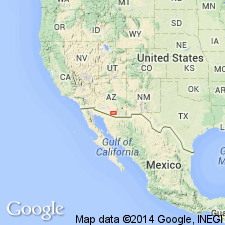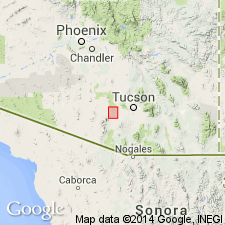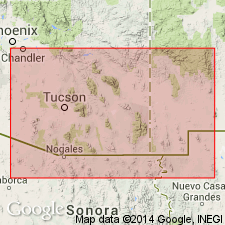
- Usage in publication:
-
- Cocoraque Formation*
- Modifications:
-
- Named
- Dominant lithology:
-
- Arkose
- Graywacke
- Quartzite
- Mudstone
- Conglomerate
- AAPG geologic province:
-
- Basin-and-Range province
Summary:
Named for Cocoraque Ranch, Roskruge Mountains, Pima Co, AZ, Basin-and-Range province. Type "localities" are along a northeast-trending dry creek and trail about 4 mi south-southeast of Cocoraque Ranch, and along a northeast-trending creek about 1 mi south of ranch. Forms smooth hills. Consists mostly of gray-green arkose and graywacke, gray quartzite, red- and gray-mottled mudstone, and pebble conglomerate. Is well bedded and well sorted. The quartzite is mostly gray subround medium-size quartz grains and minor amount of feldspar. Is about 2,000 ft thick. Base is not exposed but is presumed younger than the newly named Nolia Volcanic Formation (Mesozoic), as it contains pebbles apparently derived from Nolia. Appears to be unconformably overlain by the newly named Roadside Formation (Mesozoic). Intruded by plutonic masses, commonly quartz diorite or quartz monzonite. Is of Mesozoic age. Geologic map.
Source: GNU records (USGS DDS-6; Denver GNULEX).

- Usage in publication:
-
- Cocoraque Formation
- Modifications:
-
- Geochronologic dating
- AAPG geologic province:
-
- Basin-and-Range province
Summary:
Andesite in formation has K-Ar age of 108.1 +/-2.4 Ma.
Source: GNU records (USGS DDS-6; Denver GNULEX).

- Usage in publication:
-
- Cocoraque Formation*
- Modifications:
-
- Overview
- Age modified
- AAPG geologic province:
-
- Basin-and-Range province
Summary:
Is oldest Cretaceous formation in Roskruge Mountains (Pima Co, AZ) in Basin-and-Range province. Base is not exposed. Underlies Roadside Formation (Campanian) unconformably. Is estimated to be about 2,000 ft thick. Is correlated with Amole Arkose of Brown (1939) in Tucson Mountains on basis of lithologic similarity. Age is shown to be Aptian and Albian (Early Cretaceous) on correlation chart (fig. 5); refined from Mesozoic.
Source: GNU records (USGS DDS-6; Denver GNULEX).
For more information, please contact Nancy Stamm, Geologic Names Committee Secretary.
Asterisk (*) indicates published by U.S. Geological Survey authors.
"No current usage" (†) implies that a name has been abandoned or has fallen into disuse. Former usage and, if known, replacement name given in parentheses ( ).
Slash (/) indicates name conflicts with nomenclatural guidelines (CSN, 1933; ACSN, 1961, 1970; NACSN, 1983, 2005, 2021). May be explained within brackets ([ ]).

